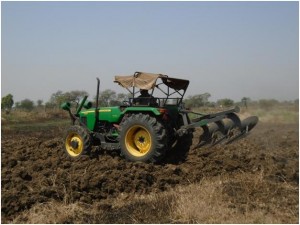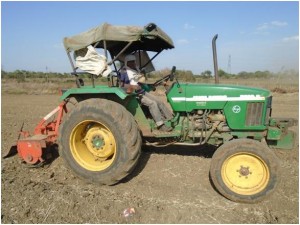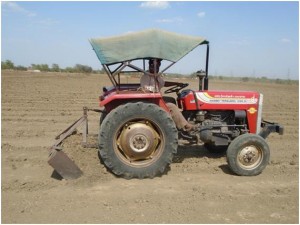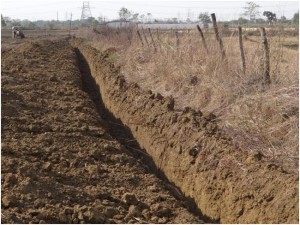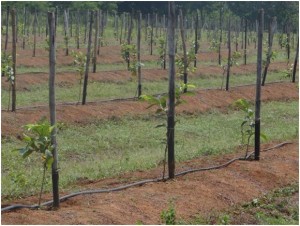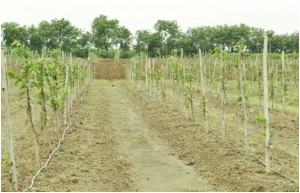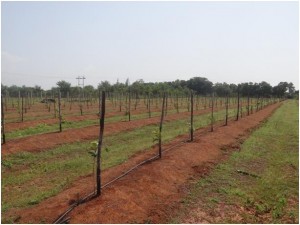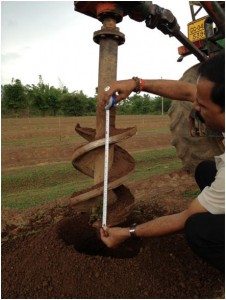Land Preparation for VNR Bihi Orchard
The first step is to study elevation and slope of the land
Elevation surveys
Precision contour surveys are essential on low slope areas. On higher slope country (slopes > 0.5%) they may not be needed because the slope direction is much less likely to be altered by minor elevation changes. The reasons for undertaking a precision contour survey are:
- To detect the dominant direction of slope;
- To identify humps and hollows that will change the direction of surface flows;
- To identify the need for local drains or Cross Drains to remove water from small depressions; and
- To plan the orientation of Raised Beds and the best location to dispose of water from the major drains at the lower end of the Raised Beds. Surveyors with the capability of undertaking precise elevation surveys and producing maps are available in country areas
Deep Ploughing
Deep ploughing of field is done twice with 12-18 inches deep plough
Why deep ploughing is required?
Deep ploughing is required for two major benefits
- It breaks the hard pan of soil, allowing better root growth & better penetration of water/ moisture.
- Exposing soil borne insects/pests to harsh atmospheric conditions, which helps in reducing their population in field.
Breaking Clods
- After deep ploughing, clods of soil are broken with a heavy rotavator.
- This is to be done 5-10 days after deep ploughing when moisture is reduced.
Benefits: This gives better texture to soil and makes it suitable for leveling & plantation.
Leveling & Slope
- Leveling of field is done to avoid water logging in uneven pockets & for convenience of activating agricultural practices, a slope of 0.5 % is made with the help of leveler to get runoff excess water.
Benefits:
- This is made to drain out excess water from field.
Leveling of 200-250 ft long patch at a time with drainage proved to be efficient and cost effective.
Drainage Trench :
- After leveling the field, a main drainage trench- 2 ft deep and 2/3 ft wide is made.
Benefits :
This ensures collection & drain of excess water from the orchard area.
MAKING RAISED BEDS
Why raised beds are required?
The prime objective for installing Raised Beds is to drain excess water from the root zones of crops and pastures.
The objectives of managing soils in Raised Beds are to create and maintain:
- A stable soil structure;
- A porous and permeable soil; and
- A deeper than normal seedbed
The desired outcomes from these management objectives are to ensure the Raised Beds function properly, that is, they:
- Drain and aerate freely, and thus prevent water logging;
- Increase root growth and proliferation, and thereby reinforce the loose structure, minimise subsidence and increase soil organic matter
- Increases plant water use, and thereby increases production
Bed Orientation
Orienting Raised Beds north-south is best. The north-south orientation allows for an even exposure of the bed to sunlight, which maximises the chances of uniform crop development across the full width of the bed.
Crops planted on a predominantly east-west orientation have the rows closest to the northern shoulder of the bed exposed to sunlight for most of the day. This causes greater soil evaporation from the northern shoulder and results in one or two crop rows growing less well and yielding less than the crop rows on the remainder of the bed. Experience has shown that a north-south orientation is best.
Raised beds have following benefits
It confines the root zone of the plant so that farmer can give water and nutrients to feeder roots.
It enhances the life of drip-laterals.
It helps in better management of weeds and other practices near stem of the plant.
It maintains optimum moisture in roots during rainfall.
Raised beds are made in N-S direction so plants can get maximum sunlight.
In waterlogged areas, raised beds are raised 3 times the level of water that field abides.
- Raised beds are made 12-16 ft (measured from centre of raised bed) apart, as per spacing model opted.
Raised beds of 15-18 inches height and 30-36 inches breadth are required for plantation.
A 16FT X 8FT VNR BIHI PLANTATION ON RAISED BED
A 12 FT X 8 FT VNR BIHI PLANTATION ON RAISED BED
SPACING
- Spacing of the orchard depends on its size due to scope of mechanical practices in between the rows.
- Labour availability is getting shorter , hence, we must have mechanical options in orchard management.
Different spacing models are suggested for VNR-BIHI Orchard:
(Row x Plant spacing mentioned below)
- 16*8 ft (340 plants/ acre) for orchards > 20 acres ( A big tractor can be used in between the rows )
- 12*8 ft (450 plants/ acre) for orchards > 03 acres ( A small tractor can be used in between the rows )
- 10*8 ft (550 plants/ acre) for orchards < 03 acres ( A power tiller can be used in between the rows )
- 8*8 ft (550 plants/ acre) for orchards < 03 acres ( A power tiller can be used in between the rows )
16*8 ft (340 plants/ acre) orchard
DIGGING PITS
Pits are required to loosen the soil and placement of required nutrients with digested FYM. It results better moisture availability for good root development and plant growth.
- Pits are dug on raised beds either manually or mechanically. Mechanical digging is efficient and cost-effective.
- For this purpose, tractor mounted post-hole digger with auger diameter 20 – 22 inches can be used.
- Post hole digger can be sourced from Agri. Implement Shops or Contractors of Forest / Electricity Departments.
Tractor driven digger can make 800 / 900 pits per day raised bed. Manually, one labour can make max. 8 – 10 pits.

